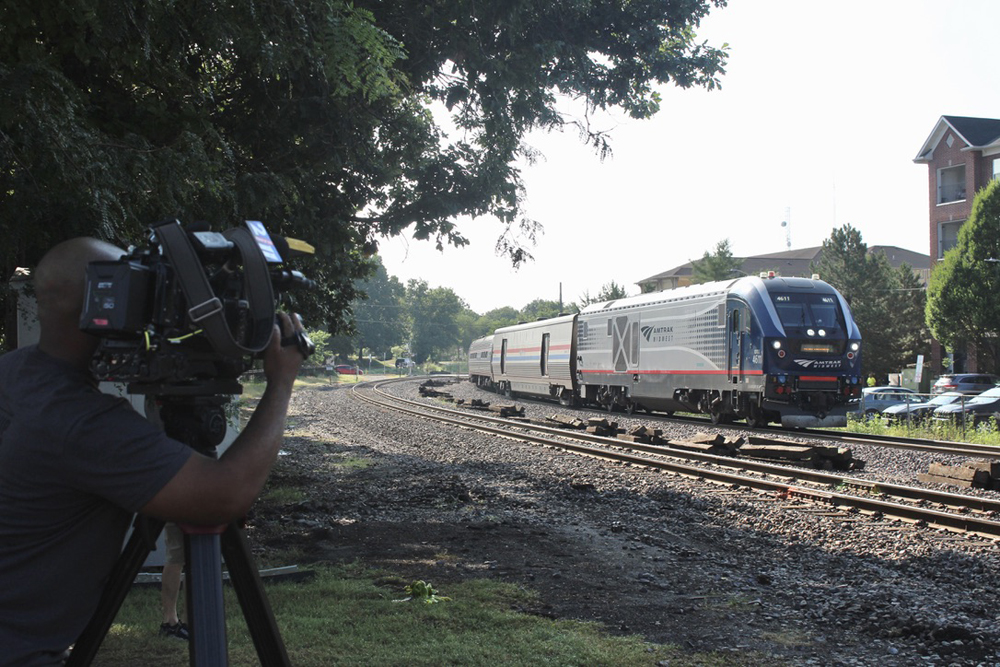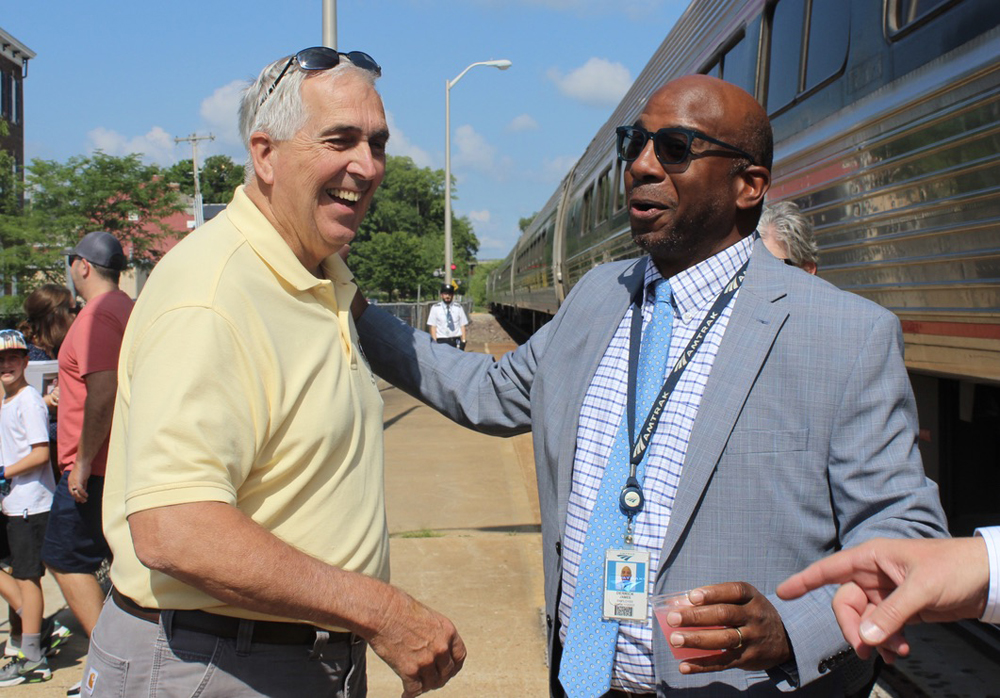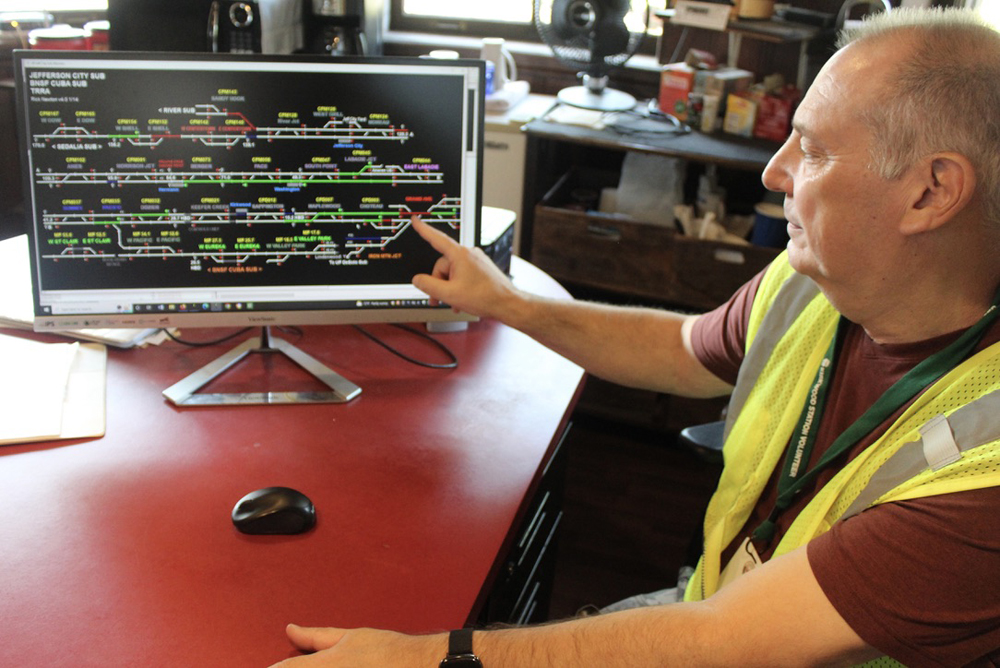
KIRKWOOD, Mo. — Well-wishers who turned out Monday morning to welcome the restored second daily Missouri River Runner at the venerable Kirkwood train station, and other stops from St. Louis to Kansas City, Mo., included travelers riding train No. 311 west for the first time since it last operated on Jan. 3, 2022, when state funding ran out.
Far more numerous were civic officials and lawmakers who fought ideological opposition to passenger rail at the state level, which caused the train’s recent hiatus.
“The annual economic impact of the River Runner to the state is over $200 million per year,” Kirkwood Mayor Tim Griffin told the crowd, citing a 2019 report compiled when two round trips were running. The study helped justify post-pandemic restoration of a second round-trip on July 19, 2021, but didn’t dissuade the Republican-controlled legislature and Gov. Mike Parson from budgeting $10.8 million instead of the $13.25 million Amtrak required.
After leaving Kirkwood, politicians at the next three stations were waiting to briefly greet Amtrak’s Midwest-based government affairs director Derrick James, who had visited their communities to provide facts that helped sell service restoration.

“I was the deciding vote!” quipped Republican State Rep. Bruce Sassmann at Hermann, Mo., while Jefferson City Mayor Carrie Tergin told Trains News Wire that getting the second train back “is important for residents to be able to easily visit the state capital.”
With equipment in short supply and the need to provide at least 30 axles to ensure proper signal shunting on Union Pacific’s St. Louis-Kansas City line, the Monday consist assembled by Amtrak included an Amfleet I cafe-business class car, three long-distance coaches, two deadhead Northeast Corridor cafe cars, and a Viewliner II baggage car behind Midwest SC-44 Charger 4611. The train’s assistant conductor had been furloughed in January, but fortunately did not leave to take another job before being called back to requalify on the route in May.
Kirkwood has a $4.6 million station and platform renovation project underway, led by a grass-roots fund-raising foundation. A $14 million state appropriation in the fiscal 2023 budget will restore Jefferson City’s Union Hotel, built in 1855. The three-story stone and brick building housed a station from 1984 until a 2019 inspection revealed the structure had become too dangerous to occupy. It was abruptly shuttered and fenced; an air-conditioned and rest-room-equipped trailer serves as a “temporary” waiting room for passengers until the 19th Century building is renovated.

Although the route doesn’t have checked baggage service or ticket agents, volunteers and city employees help fill the void. At Jefferson City, Tergin was on hand with her children to thank volunteers passing out water and cookies when the train arrived.
“Most stations have a city employee or volunteers to meet each train,” says Jefferson City volunteer Steve Buersmeyer, who was told by Amtrak’s James at a recent meeting that his town would be getting a new Americans With Disabilities Act-compliant platform next year. At Kirkwood, a town that pioneered its station host program decades ago, station manager Bill Burckhalter makes departure announcements as volunteers Joe Wolf and Ron Zimmer offer printed schedules to first-time riders.
A team effort restored funding and relaunched the second round trip. Now the challenge will be to maintain momentum by drawing travelers to the station.














CN requires 24 axle minimums on the Wolverine and Blue Water Routes in Michigan as well.
Can anyone further explain the requirement for a minimum number of axles? Is the signaling infrastructure somehow cheaper for the host railroads when there’s an axle minimum? More technologically feasible? We’ve read of this on other routes, and one result would seem to be wasted use of passenger equipment. There’s extra cost for mileage-based maintenance, and loss of revenue from the cars not being available on routes where they could be filled instead of riding empty.
BULLSEYE
“Bullseye” to Messers. Miller and Lustig. The only other route so
“afflicted” that I know of is the former IC CHI-CDL. Seems to me President Biden’s hand-picked FRA administrator Amit Bose and SecTrans Buttigieg ought to doing a “deep dive” into this situation with intent to getting it fixed.
Funny Mark Shapp, hahaha. My senile cat Burlington asks why he never got paid paternity leave for months when nothing was getting done. (Uh, Burlington, maybe that trip to the vet when you were a young adult …..)
Come to think of it, we’d be much better off if Buttigieg still were at home raising the child. He’d be doing far less damage.
Speaking of CHI-CDL, when does that route get its second train restored? Who is holding that up, ILDOT, Amtrak? Who?
I’d like to know that too
If memory serves, they are waiting for the new cars to be “fixed” to meet Amtrak standards. I think it was the lavatories had an unapproved method of piping or shelving.
To add insult to injury, not only does CN require 30 axles to activate crossings, Amtrak used Superliner cars on the remaining Saluki and Illini because CN requires heavier cars to activate the crossings between Mattoon and Kinmundy. Why I wonder.
From my recollection, the issue with axle count is that shorter trains don’t reliably activate grade crossings along the route, resulting in delayed or possibly failed crossing activations (not good!). Why is not entirely certain, seems to have something to do with the rails in those areas. The issue seems to be unique to those few routes, however.
As for why Amtrak doesn’t use revenue cars and sell more seats, I’m not entirely certain. Right now it’s likely a case of “not enough crewmembers” or “not enough revenue cars” to do that, note that they’re using baggage cars and cafes instead of coaches. Or they decided the incremental cost of staffing the cars outweighed the extra revenue from passengers, assuming demand was high enough, which may have been the case pre-2020.
From what I understand, BNSF only requires a 12 axle count to activate crossings. Why can’t CN and UP.
Charles,
Some of the figures may come from here:
https://www.modot.org/sites/default/files/documents/2022%20MoDOT%20Freight%20Rail%20Plan%20Passenger%20Rail%20Technical%20Report_1.pdf
The right honorable mayor states the annual impact of a second train is $200 Million per year.
Substantiation?